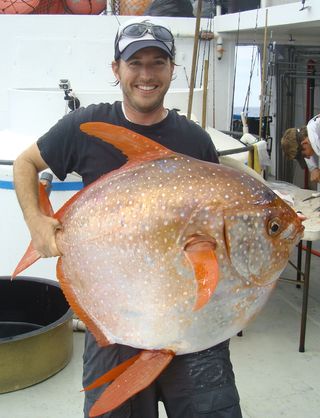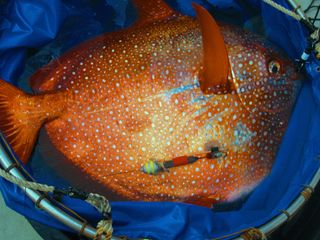Moonfish: The first warm-blooded fish (photos)
The moonfish, which are about the size of a manhole cover, is now considered the first-known warm-blooded fish, scientists report in the journal Science. Through some physiological tricks, the fish is able to keep its entire body — heart, brain, swimming muscles and viscera — warmer than the surrounding water. Here are photos of the distinguished fish, which is also called an opah. [Read the full story on the warm-blooded moonfish]

In the study, the researchers attached temperature sensors and satellite tags to moonfish that allowed tracking of the fish's movements and habitat preferences for up to eight months. The team monitored the moonfish body temperatures while the fish dove, finding that no matter what depth they were at, the fish's body temperature hovered around 9 degrees Fahrenheit (5 degrees Celsius) warmer than the surrounding water. Shown here, biologist Owyn Snodgrass prepares an opah for release with its temperature sensor. (Photo Credit: NOAA)

Much of the body heat produced by the opah seems to come from their dark-red aerobic pectoral muscles used during swimming, the researchers found. Unlike many other fish that undulate their bodies to move forward, the opah flaps its winglike pectoral fins to swim. This heat-generating pectoral muscle is insulated from the chilly water with a layer of fat. (Photo Credit: NOAA)

The researchers found the opah's blood vessels in the gill tissue are arranged in such a way that the vessels transporting cool, oxygenated blood from the gills to the body are in contact with those that move warm, deoxygenated blood in the opposite direction -- from the body to the gills. In that way, the outgoing blood warms up the incoming blood. (Photo Credit: NOAA)

The researchers found the opah is able to increase the temperature of its heart, which likely helps the fish dive to depths and remain there for longer periods than they would otherwise be able to do. Other endothermic fish such as tunas and lamnid sharks, which can't warm their heart, must return to the surface in between deep dives to warm up, the researchers noted. Here, study researcher Nick Wegner, a biologist with NOAA's Southwest Fisheries Science Center, holds a captured opah. (Photo Credit: NOAA Fisheries, Southwest Fisheries Science Center)

The opah, however, are known to spend most of their time at depths between 160 and 1,300 feet (50 and 400 meters) without regular visits to the surface for warming up. The opah shown is equipped with a temperature sensor. (Photo Credit: NOAA)

The warm body core, heart and cranial region give the opah enhanced physiological capabilities, the researchers said. For instance, the toasty temperature should increase their muscle power and their capacity for sustained swimming. (Photo Credit: NOAA)
Sign up for the Live Science daily newsletter now
Get the world’s most fascinating discoveries delivered straight to your inbox.

Biologist Owyn Snodgrass prepares to insert a thermocouple into the pectoral muscles of a captured opah to record internal and external temperatures following release. (Photo Credit: NOAA)

Opah are found across the globe in tropical and temperate waters, often pulled up as bycatch by longliners fishing in the deep ocean for tunas and billfish, according to the National Oceanic and Atmospheric Administration (NOAA). Since the opah fish don't swim in schools, they're not caught in great numbers, NOAA said. Shown here, an opah released with sensors that allow for recording of depth, water temperature and the fish's internal body temperature. (Photo Credit: NOAA)
Warm eyes

Along with other areas of the body, the elevation of temperature of the eye and brain should allow opah to increase visual temporal resolution and neural conductance. (Photo Credit: NOAA Fisheries, Southwest Fisheries Science Center)
Follow us @livescience, Facebook & Google+.

Jeanna served as editor-in-chief of Live Science. Previously, she was an assistant editor at Scholastic's Science World magazine. Jeanna has an English degree from Salisbury University, a master's degree in biogeochemistry and environmental sciences from the University of Maryland, and a graduate science journalism degree from New York University. She has worked as a biologist in Florida, where she monitored wetlands and did field surveys for endangered species. She also received an ocean sciences journalism fellowship from Woods Hole Oceanographic Institution.
